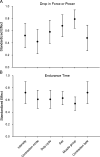Systematic review and meta-analysis of skeletal muscle fatigue in old age
- PMID: 20881888
- PMCID: PMC3705929
- DOI: 10.1249/MSS.0b013e3181f9b1c4
Systematic review and meta-analysis of skeletal muscle fatigue in old age
Abstract
Despite intense interest in understanding how old age may alter skeletal muscle fatigability, a quantitative examination of the impact of study design on age-related differences in muscle fatigue does not exist.
Purpose: The purpose of this study was to conduct a systematic review of the differences in muscle fatigue between young and older adults, with specific examination of moderator variables suggested to contribute to discrepancies across studies: contraction intensity, contraction mode, duty cycle, fatigue index, sex, muscle group, and contraction type.
Methods: The standardized effect of age on muscle fatigue was computed for 37 studies (60 standardized effects). Standardized effects were coded as positive when less fatigue was reported in older individuals compared with young individuals.
Results: The overall standardized effect of age on muscle fatigue was positive (0.56). In studies using dynamic contractions or using muscle power as the index of fatigue, the standardized effect was negative (-0.12 and -2.5, respectively). The standardized effect for all other moderator categories was positive (range = 0.09-0.90), indicating less fatigue in older adults under all other methodological conditions.
Conclusion: This review provides the first quantitative analysis of the effect of study design on age-related differences in muscle fatigue. The results indicate that older individuals develop less muscle fatigue than young individuals, particularly during isometric contractions of the elbow flexor and knee extensor muscles. However, the results also suggest that older adults develop greater fatigue during dynamic contractions, particularly when the decline in power is assessed. Studies that verify this latter outcome are needed, as are studies designed to elucidate the mechanisms of fatigue.
Figures



Similar articles
-
Physical exercise training interventions for children and young adults during and after treatment for childhood cancer.Cochrane Database Syst Rev. 2016 Mar 31;3(3):CD008796. doi: 10.1002/14651858.CD008796.pub3. Cochrane Database Syst Rev. 2016. PMID: 27030386 Free PMC article.
-
Drugs for preventing postoperative nausea and vomiting in adults after general anaesthesia: a network meta-analysis.Cochrane Database Syst Rev. 2020 Oct 19;10(10):CD012859. doi: 10.1002/14651858.CD012859.pub2. Cochrane Database Syst Rev. 2020. PMID: 33075160 Free PMC article.
-
Educational interventions for the management of cancer-related fatigue in adults.Cochrane Database Syst Rev. 2016 Nov 24;11(11):CD008144. doi: 10.1002/14651858.CD008144.pub2. Cochrane Database Syst Rev. 2016. PMID: 27883365 Free PMC article.
-
Systemic pharmacological treatments for chronic plaque psoriasis: a network meta-analysis.Cochrane Database Syst Rev. 2021 Apr 19;4(4):CD011535. doi: 10.1002/14651858.CD011535.pub4. Cochrane Database Syst Rev. 2021. Update in: Cochrane Database Syst Rev. 2022 May 23;5:CD011535. doi: 10.1002/14651858.CD011535.pub5. PMID: 33871055 Free PMC article. Updated.
-
Effects of Supervised vs. Unsupervised Training Programs on Balance and Muscle Strength in Older Adults: A Systematic Review and Meta-Analysis.Sports Med. 2017 Nov;47(11):2341-2361. doi: 10.1007/s40279-017-0747-6. Sports Med. 2017. PMID: 28573401
Cited by
-
Comments on point:counterpoint: skeletal muscle mechanical efficiency does/does not increase with age.J Appl Physiol (1985). 2013 Apr;114(8):1114-8. doi: 10.1152/japplphysiol.00185.2013. J Appl Physiol (1985). 2013. PMID: 23588541 Free PMC article. No abstract available.
-
Performance Fatigability: Mechanisms and Task Specificity.Cold Spring Harb Perspect Med. 2018 Jul 2;8(7):a029728. doi: 10.1101/cshperspect.a029728. Cold Spring Harb Perspect Med. 2018. PMID: 28507192 Free PMC article. Review.
-
Relationships between Physiological and Self-Reported Assessment of Cancer-Related Fatigue.Int J Exerc Sci. 2022 Jan 1;15(3):177-190. doi: 10.70252/SSZO6869. eCollection 2022. Int J Exerc Sci. 2022. PMID: 36895434 Free PMC article.
-
Neuromuscular fatigue in young and older men using constant or variable resistance.Eur J Appl Physiol. 2013 Apr;113(4):1069-79. doi: 10.1007/s00421-012-2526-2. Epub 2012 Oct 19. Eur J Appl Physiol. 2013. PMID: 23079866 Clinical Trial.
-
On the role of skeletal muscle acidosis and inorganic phosphates as determinants of central and peripheral fatigue: A 31 P-MRS study.J Physiol. 2022 Jul;600(13):3069-3081. doi: 10.1113/JP283036. Epub 2022 Jun 2. J Physiol. 2022. PMID: 35593645 Free PMC article.
References
-
- Allman BL, Cheng AJ, Rice CL. Quadriceps fatigue caused by catchlike-inducing trains is not altered in old age. Muscle Nerve. 2004;30(6):743–51. - PubMed
-
- Allman BL, Rice CL. Incomplete recovery of voluntary isometric force after fatigue is not affected by old age. Muscle Nerve. 2001;24(9):1156–67. - PubMed
-
- Allman BL, Rice CL. Neuromuscular fatigue and aging: central and peripheral factors. Muscle Nerve. 2002;25(6):785–96. - PubMed
-
- Allman BL, Rice CL. Perceived exertion is elevated in old age during an isometric fatigue task. Eur J Appl Physiol. 2003;89(2):191–7. - PubMed
Publication types
MeSH terms
Grants and funding
LinkOut - more resources
Full Text Sources
Medical

